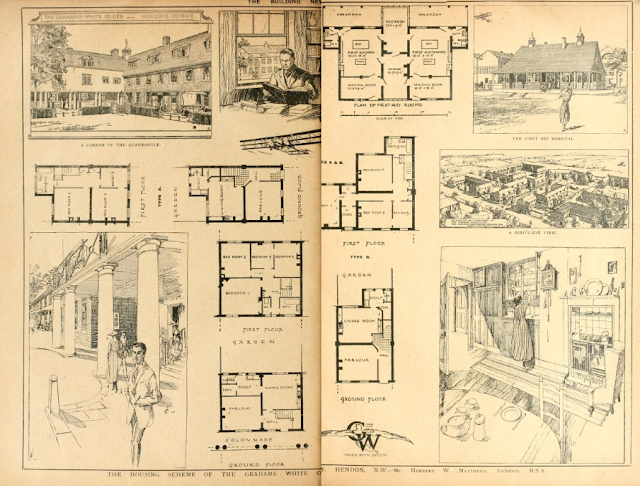I went for a walk in Woodford with my friend Sue, who lives there but doesn’t like to be photographed (at least not from the front).
Down at the station there was Popeye,
and up on the Green there was Winston Churchill
and in between there was much to fascinate the urban or suburban walker; this kind of thing:
But I had given myself a small mission, to see the house of James Hilton, the author of the novel Lost Horizon. He was living in Oak Hill Gardens when he wrote that book (now part of Woodford, but part Walthamstow at the time. He was also there when he wrote his other greatest hit Goodbye, Mr. Chips.
Now, I suspect few youngsters and even quite a few oldsters are unfamiliar with Lost Horizon although as you see, Hilton was once famous enough that his name was thought powerful enough to sell booze.
But everybody’s surely heard of Shangri-La, the mythical Tibetan kingdom run by lamas, where people can live to an unheard of great age. It’s still a surprisingly readable book - I just read it - and it seems extremely modern in a lot of respects. The sexual politics are inevitably a bit dodgy, the racial politics less dodgy than you might expect.
There’s a film too, starring Ronald Coleman as the heroic Conway, directed by Frank Capra, which is ruthlessly unfaithful to the original – the missionary from the novel becomes a floozy, Conway suddenly has a brother, and Edward Everett Horton pops up as a paleontologist.
Actually there's a later film, a musical version (OMG), starring Peter Finch and Liv Ullman which is generally said to be cosmically awful.
The book was written in the winter of 1932 when Hilton already knew that things were already looking bleak for the world, even from the suburban outpost in Walthamstow, and he imagined a place where a small pocket of civilization could survive however terrible the approaching cataclysm.
It wasn’t hard to find James Hilton’s house – it has a blue plaque, and whoever lives in the house now isn’t shy about expressing their personality. And if you look closely you can see a skeleton hanging in the front window. and it could be a leftover from Halloween but since my visit was in February they’ve obviously grown fond of having it around. Their mailbox, if that's what is, is impressive too.
Woodford is about as suburban and respectable a place as you can imagine, and although I haven’t been able to find any comments Hilton made about the place, his description of Shangri-La seems extraordinary sounds very much like Middle England.
Chang explains how things are in Shangri-La: “If I were to put it into a very few words, my dear sir, I should say that our prevalent belief is in moderation. We inculcate the virtue of avoiding excesses of all kinds -even including, if you will pardon the paradox, excess of virtue itself … And I think I can claim that our people are moderately sober, moderately chaste and moderately honest.” This sounds more Church of England vicar than Tibetan lama.
And Chang describes the lack of crime in Shangri-La, attributing it to the fact that only serious things were considered crimes and “partly because everyone enjoyed a sufficiency of everything he could reasonably desire.”
You think it’s starting to go off the rails a bit when Chang says, “You English inculcate the same feeling in your publics schools,” but then there’s a wonderful swerve, as he says, “but not I fear for the same things. The inhabitants of our valley, for instance feel that it is ‘not done’ to be inhospitable to strangers, to dispute acrimoniously, or to strive for priority amongst one another. The idea of enjoying what your English headmasters call the mimic warfare of the playing field would seem to them entirely barbarous, indeed, a sheer wanton simulation of all the lower instincts.” By which I suppose we can assume Hilton wasn’t good at sports.
Hilton became a very successful Hollywood screen writer and moved to California, where he won an Oscar for the script of Mrs. Miniver but interestingly (to me) he didn’t live in Beverley Hills or the Hollywood Hills where so many successful writers go; for the last ten years of his life (he died youngish, aged 54) he lived in Long Beach, in a bungalow on Argonne Avenue. I haven’t been able to find the number of the house, but part of the street looks like this on Streetview:
I’ve certainly walked around in Long Beach, though not down Argonne Street, and it’s a very different kind of suburbia from Woodford (or Walthamstow), but it’s still a member of the species.
Even at the time it evidently seemed an odd place for an Oscar-winning writer to make his home and Hilton was happy to explain in an interview: “I want to live in America. I want to write about it. You can’t get the feel of the country from Hollywood, so I came to Long Beach.”
Perhaps the same could be said about England and Woodford. Depending on how you slice it, Hilton either came a long way or not very far at all. That horizon wasn’t so lost, or distant, after all.

































